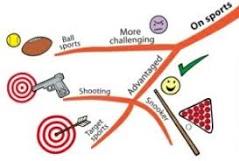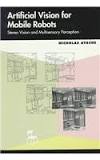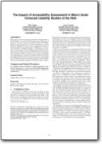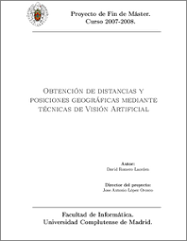artificial binocular vision

Screen reader users, click here to load entire articleThis page uses JavaScript to progressively load the article content as a user scrolls. Screen reader users, click the load entire article button to bypass dynamically loaded article content. Volume 41, April 2016, Pages 505–514 Artificial 3-D contactless measurement in orthognathic surgery with binocular stereo visiona b c Received 3 December 2015, Revised 9 January 2016, Accepted 13 January 2016, Available online 25 January 2016•A learning mechanism eliminating the need of surgeon marking the teeth location.•Pre-operative 3-D images trained with artificial methods could aid locate the teeth.•The artificial contactless repositioning ensures statistically acceptable accuracy.•Help the process of quality inspection throughout the operation.•A good alternative to manual measurements which are prone to high error rates.Stereo vision systems are utilized since it provides contactless measurements of objects in 3-D (three-dimensional).

Orthognathic surgery is a very sensitive operation that requires very high accuracy in measurements. The reduction of measurement error is an essential problem in orthognathic surgery. Moreover, quality inspection of the process during the course of operation aids the surgeon to avoid or minimize the mitigating circumstances.
binocular chordsIn this paper, artificial intelligence methods (neural network and neuro-fuzzy system) are used in order to increase the accuracy of positioning of jaws during the real-time practice.
buy nikon binoculars online indiaThe comparison of artificial measurements with the real measurements shows that a statistically acceptable accuracy is achieved in 3-D positioning of teeth.
binoculars las vegas nv
Graphical abstractKeywords; ; ; ; Copyright © 2016 Elsevier B.V. Volume 43, Issue 3, February 2003, Pages 269–283 Simulations of artificial vision were performed to assess “minimum requirements for useful artificial vision”. Retinal prostheses will be implanted at a fixed (and probably eccentric) location of the retina. To mimic this condition on normal observers, we projected stimuli of various sizes and content on a defined stabilised area of the visual field. In experiment 1, we asked subjects to read isolated 4-letter words presented at various degrees of pixelisation and at various eccentricities. Reading performance dropped abruptly when the number of pixels was reduced below a certain threshold. For central reading, a viewing area containing about 300 pixels was necessary for close to perfect reading (>90% correctly read words). At eccentricities beyond 10°, close to perfect reading was never achieved even if more than 300 pixels were used. A control experiment using isolated letter recognition in the same conditions suggested that lower reading performance at high eccentricity was in part due to the “crowding effect”.

In experiment 2, we investigated whether the task of eccentric reading under such specific conditions could be improved by training. Two subjects, naive to this task, were trained to read pixelised 4-letter words presented at 15° eccentricity. Reading performance of both subjects increased impressively throughout the experiment. Low initial reading scores (range 6%–23% correct) improved impressively (range 64%–85% correct) after about one month of training (about 1 h/day). Control tests demonstrated that the learning process consisted essentially in an adaptation to use an eccentric area of the retina for reading. These results indicate that functional retinal implants consisting of more than 300 stimulation contacts will be needed. They might successfully restore some reading abilities in blind patients, even if they have to be placed outside the foveal area. Reaching optimal performance may, however, require a significant adaptation process.Over the last few years, several research groups have initiated important projects aiming at the development of visual prostheses for the blind (Chow & Chow, 1997;

Humayun & de Juan, 1998; Normann, Maynard, Rousche, & Warren, 1999; Rizzo & Wyatt, 1997; Veraart et al., 1998; Zrenner et al., 1999). Increasing interest in this domain is essentially due to recent progress in micro-technology. One issue of major importance, when considering the conception of a visual prosthesis, is the determination of minimum requirements for useful artificial vision. We used simulations of artificial vision with normal subjects to assess this issue. Our simulations were designed to mimic artificial vision produced by a retinal prosthesis, but some of the results may also be of interest for prostheses located at other levels of the visual pathways (e.g. stimulating the optic nerve or the visual cortex).In everyday life, current visual tasks can be divided into three main classes: recognition of (small) shapes as it is specifically required for reading, localisation of objects in 3D familiar-scale environments and spatial orientation including whole body mobility. All of them have to be thoroughly studied to determine what is the minimal visual information required to restore a useful visual function.

In this study, we focussed on reading.Understanding the fundamentals of reading has received a lot of attention. One of the main research centres in this field is the laboratory for low vision research at the University of Minnesota. These authors have systematically studied various aspects of reading psychophysics in normal subjects and low vision patients. For normal subjects, Legge, Pelli, Rubin, and Schleske (1985) reported that maximum reading rates are achieved for characters subtending 0.3°–2° of visual angle; that reading rate increases with field size, but only up to 4 characters, independently of character size; that reading rates increase with sample density, but only up to a critical density which depends on character size, when the text is matrix sampled or pixelised. Reading was also found to be very tolerant to either luminance or colour contrast reductions (Legge & Rubin, 1986; Legge, Rubin, & Luebker, 1987; Legge, Parish, Luebker, & Wurm, 1990). At very low (<10%) luminance contrast however, reading speed drops due to prolonged fixation times and to an increased number of saccades, presumably related to a reduced visual span (Legge, Ahn, Klitz, & Luebker, 1997).

When testing the effect of print size on reading speed in normal peripheral vision, it was found that the use of larger characters improves peripheral reading to some extent, up to a critical print size (Chung, Mansfield, & Legge, 1998). But maximum reading speed also decreased from about 808 words/min for foveal vision to about 135 words/min for peripheral vision at 20° eccentricity.1 Thus print size was not found to be the only factor limiting maximum reading speed in normal peripheral vision, contradicting the scaling hypothesis (Latham & Whitaker, 1996; Toet & Levi, 1992) which implies that peripheral word recognition can be made equal to that at the fovea by increasing print size.In low-vision patients, reading is similar to normal reading in several aspects (Legge, Rubin, Pelli, & Schleske, 1985; Legge et al., 1990; Legge et al., 1997; Rubin & Legge, 1989), but difficult to predict on the basis of routine clinical evaluations (Legge, Ross, Isenberg, & La May, 1992). As a rule however, it can be stated that low-vision patients with central field defects achieve lower reading rates than those with preserved central fields (Legge et al., 1985;

Rubin & Legge, 1989).The studies quoted above (as well as many others) have led to the identification of a series of important parameters that are critical for reading in normal and low vision subjects. To our knowledge, there is however only a limited number of studies, which were specifically oriented towards the development of visual prostheses. Cha, Horch, Normann, and Boman (1992) used a pixelised vision system to simulate artificial vision in normal subjects. Their results showed that a 25×25 array of pixels representing 4-letters of text projected on a foveal visual field of 1.7° is sufficient to provide reading rates near 170 words/min using scrolled text, and near 100 words/min using fixed text. This investigation was conducted within the frame of a project, which aimed at developing a cortical visual implant (Normann et al., 1999). Another research group, developing a retinal implant to stimulate remaining retinal neurons in photoreceptor degenerative diseases (Humayun et al., 1999), conducted experiments on the properties of pixelised vision at the Johns Hopkins University of Baltimore (Dagnielie, Thompson, Barnett, & Zhang, 2000;

Thompson, Barnett, Humayun, & Dagnelie, 2000). Reading speed and facial recognition were measured by simulating prosthetic vision in the central visual field using a head mounted video display. Subjects used eye movements to scan the stimuli through a pixelising grid. Several grid parameters were explored. Results demonstrated reading speeds up to 100 words/min, which dropped off (a) when the grid size covered less than 4 letters, (b) when a grid density of less than 4 pixels per letter width was used, or (c) when more than 50% of the pixels were randomly turned off.In all previous experiments attempting to mimic conditions of artificial vision, eye movements could be used to scan a target with the fovea. However, the anatomo-physiology of the retina does not favour a foveal location for such prostheses (see e.g. Sjöstrand, Olsson, Popovic, & Conradi, 1999). Retinal implants are primarily designed to stimulate neurones of the inner retinal layers in cases of photoreceptor loss (e.g. retinitis pigmentosa).

Surviving bipolar and/or ganglion cells are the targets for electrical stimulation. In the central fovea, these neurons are not present. In the parafovea, they are arranged in several superimposed layers that makes it difficult to activate them in predictable patterns. The best sites for retinotopic activation without major distortion are located beyond the parafoveal region. Such eccentric locations as well as the fact that a retinal implant will stimulate a fixed area of the retina have apparently not yet been fully taken into consideration. The aim of the present research work was to assess reading performance with a system projecting stimuli onto defined, stabilised areas of the visual field placed at various eccentricities. In experiment 1, we studied the influence of stimulus pixelisation, stimulus eccentricity and stimulus size on reading performance. In experiment 2, we investigated whether the task of eccentric reading under such specific conditions could be improved by training.